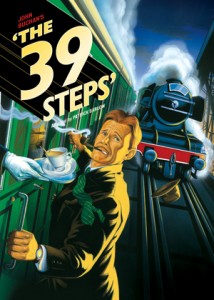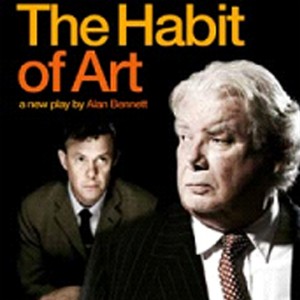I have now seen a total of five shows here in London. First, the Merry Wives of Windsor at the Globe Theatre, followed by the Czech Philharmonic concert at Royal Albert Hall, Les Miserables at the Queen’s Theatre, The 39 Steps at the Criterion Theatre, and The Habit of Art at the National Theatre. For this blog post, I will focus on The 39 Steps and The Habit of Art, because I think these shows have certain things in common that are a good demonstration of British culture.
Both shows were distinctly meta-theatrical. In The 39 Steps, costume and set changes happened right on stage and Professor Jordan proclaims the show’s self-consciousness when he is shot by a bodiless arm at the end of the show and shouts “This is supposed to be a four person cast!” The Habit of Art is a play within a play. Better yet, the play within the play is being rehearsed at the National Theatre, where the play is being shown. The rehearsal of Caliban’s Day is frequently interrupted by the actors, the stage manager, and the writer to talk about the trials and tribulations of acting, writing, and theatre. I think that both of these shows’ use of meta-theatre demonstrates the British love of irony and humor, their tendency toward self-consciousness and self-deprecation, and the Importance of Not Being Earnest Rule as defined by Kate Fox. Meta-theatre demonstrates that the show and the playwright are not taking themselves too seriously. When some of the class was talking during intermission, I remember Matt wondering why there couldn’t have just been a play about Auden and Britton, and why they had to go to the trouble of adding all the extra characters and putting it in a frame. He suggested that the playwright was too worried that a serious play about Auden and Britton would not go over well. This theory may be exactly right. A play just about Auden and Britton may have been reviewed with an “Oh come off it” rather than a “deeply and unexpectedly moving” and a “I can think of few plays that combine wild laughter, deep emotion, and technical ingenuity with such bravura” (Charles Spencer, Telegraph, 18 November 2009).
photo credit: Google Images
photo credit: Google Images
This is still just a theory. As a sidenote, I do think the framing had its merits. Caliban’s Day is about the pressure to create art, the artist’s consciousness of his role and reputation as an artist, and the contriving that goes on behind the scenes with the artist’s fear of biographical information seeping into or being read into his art. The insecure actors and writer and the ever-comforting and conciliatory stage manager are a parallel story to Auden’s and Britton’s, allowing the themes to be developed more deeply and thoroughly, applying them to theatre as well as poetry and music.
We have talked about theatre in London as being a sort of equalizer. Anyone who can afford even fifteen pounds can get a pretty good seat for a show. In the National Theatre, there are no restricted view seats nor are there any boxes. Everyone is on the same footing, and to demonstrate this, we got to sit in the same row as Sir Ian McKellen at The Habit of Art. While all of this is true, I still felt like a bit of an outsider at both of these shows. I really enjoyed The 39 Steps, but I still had some trouble catching all of the jokes, even after having read Fox and lived in London for a month. Many of the jokes, such as the jokes about Welsh politics and the “sorry, sorry, sorry” sequence on the train are distinctly British, and not fully accessible to us foreigners. The same held true with the humor in The Habit of Art. I’m not complaining; I’m sure American movies and plays present the same problems to the British. I do think I have a point though, in saying that the content in The Habit of Art was not accessible to just anyone. I think in order to fully understand the play, you needed a reasonable understanding of theatre and its operations (in this respect our backstage tour helped a lot) and an understanding of Auden’s biography, his poetry and The Tempest. It took me probably until close to intermission to grasp who all the characters were and the plotlines of both stories. I think the play was rather intellectual, despite containing much crude humor, and perhaps did not quite match the humble and universally accessible National Theatre.



1 response so far ↓
Mary Kate // Sep 19th 2010 at 12:16
I agree with everything you’re saying, Kaitlin, but I’m wondering if the same really can be said for American film and theater, in terms of exclusivity, at least. You’ll notice that on buses and Tube station walls, most advertised films are American. I know the National Theater promotes British playwrights old and new, but other theaters feature shows of American origin – I didn’t see All My Sons, but I wonder if someone who did could tell us whether the subject matter and jokes seem accessible to non-Americans.
All I’m saying is, it would be pretty hard for American theater and cinema to have the same inside-baseball feel as British theater does, for the simple reason that we export to the rest of the world. And from my experience so far with British theater, it certainly seems that Brits love their inside jokes.
You must log in to post a comment.